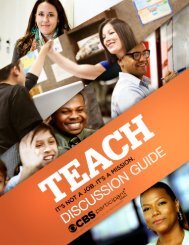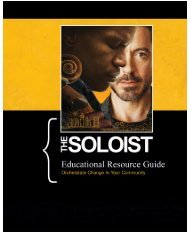Sharpen your conflict resolution skills with our activity guide - TakePart
Sharpen your conflict resolution skills with our activity guide - TakePart
Sharpen your conflict resolution skills with our activity guide - TakePart
- No tags were found...
Create successful ePaper yourself
Turn your PDF publications into a flip-book with our unique Google optimized e-Paper software.
Procedures:1. Begin class <strong>with</strong> the following j<strong>our</strong>nal prompt written on the chalkboard or on chartpaper. Allow 10 minutes for students to respond in writing in their j<strong>our</strong>nals or notebooks.Imagine that you have a personal problem that you want to share <strong>with</strong> <strong>y<strong>our</strong></strong> best friend. How would youwant <strong>y<strong>our</strong></strong> friend to respond when you told him/her? How would you want <strong>y<strong>our</strong></strong> friend to act after he/sheknew? Make a list of as many things that you can think of that describe how you’d want <strong>y<strong>our</strong></strong> friend actonce he/she heard what you had to say.Note: Possible answers might be: I’d want him/her not to laugh at me; not to tell anyone else; notto criticize me; just to listen; to ask me more about it; to give me advice, to not give me advice,but just to listen to me; to be honest, etc.2. Conduct a short discussion <strong>with</strong> the class about their j<strong>our</strong>nal entries. Ask for volunteersto share one of the items from their lists. Record their responses for the group on thechalkboard or on chart paper. If there are relevant responses not offered by the class,suggest them and add them to the list on the board.3. Ask the class to look at the list they created. Ask them to talk about what they see.4. Explain that this is the beginning of a list of “rules” for how to have a productive andsupportive dialogue <strong>with</strong> their peers. Point out to the class how much is already on theboard. This shows that they already know a lot about what it means to have a respectfulconversation.5. Divide the class into groups of 3-4 students. Assign each group one of the items from theboard.6. Allow 10 minutes for each group to discuss their term/phrase. Each group should preparethe following:• A definition of their term/phrase• An example in conversation of their term/phrase• An explanation of why their term/phrase is important to a respectful conversation7. Allow 5-10 minutes for each group to report back to the class. Record their responses.8. Explain that these are good rules to follow during class discussions–especiallydiscussions where students are sharing personal opinions.9. Create a new list of “ground rules for discussion” from the small group work. Add anyother “rules” that are not already listed. Post this list in the classroom for futurereference.Note: Examples of some important ground rules to include might be:• Listen to–and HEAR–<strong>y<strong>our</strong></strong> peers• Be willing to share <strong>y<strong>our</strong></strong> thoughts• Be open to new ideas–<strong>y<strong>our</strong></strong> own, and others • Be respectful• Agree to disagree sometimes• Don’t interrupt• Keep it confidential• Avoid using put-downs or making jokesVisit http://gsi.berkeley.edu/textonly/res<strong>our</strong>ces/discussion/methods.html for additional ground rulesactivitieswww.takepart.com/JimmyCarterManFromPlains









